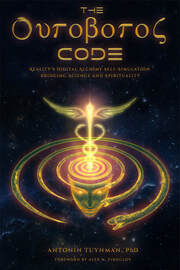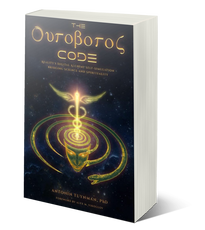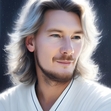Digital Physics: Does Reality Code Itself into Existence?
by Dwight Harris  "Reality can exist as a code which both transcends and yet inhabits the world it creates, which is essentially physical yet can process information independent of the type of carrier and be metaphysical in that sense... A system which incorporates and embodies itself by self-reference." -Antonin Tuynman, PhD, The Ouroboros Code
"Reality can exist as a code which both transcends and yet inhabits the world it creates, which is essentially physical yet can process information independent of the type of carrier and be metaphysical in that sense... A system which incorporates and embodies itself by self-reference." -Antonin Tuynman, PhD, The Ouroboros Code
A fundamental question of philosophy is why is there something rather than nothing. Is existence forever tied to this split, reflected in the dualism of being and consciousness knowing? Dr. Antonin Tuynman argues for a unification in a self-rising of the Cosmos (not only the physical universe).
 The book begins with Tuynman walking into a bookstore and picking up a book called "The Ouroboros Code." As he begins to read, he realizes that the words in the book are his own thoughts while he is thinking them. Like a serpent eating its own tail, the book is reading itself. But it is doing something more: It is writing itself, and doing so through the thoughts of the reader.
The book begins with Tuynman walking into a bookstore and picking up a book called "The Ouroboros Code." As he begins to read, he realizes that the words in the book are his own thoughts while he is thinking them. Like a serpent eating its own tail, the book is reading itself. But it is doing something more: It is writing itself, and doing so through the thoughts of the reader.
The traditional image of the Ouroboros has the serpent's tail already inside its mouth. The book cover, in a rare and telling instance of an image enlightening content, pictures the serpent catching up. Indeed, existence is multiple serpents, all chasing their tails. (Perhaps their "tales?"). Multiple serpents mirror the 7 chakras with the human Kundalini rising up through them into the freeing wings of Hermes. If it is eating its tail, the cosmos is a self-consuming paradox. If it is chasing, the cosmos is self-fulfilling.
The serpent is not merely an objective symbol, but a subjective experience. It is like a computer code coding itself. Like a mapping whose map is its territory, existence codes itself into existence. For Tuynman, this means experience is fundamental. "The underlying ground of existence is conscious energy." With one of his many unifying coinages, he calls it "Conscienergy." Computations are a product of sense.
Sentience is present at the smallest relative locality, a "reality cell," progressively mapping function to structure in a hierarchy of levels, particles to atoms to molecules to cells to organisms, etc. Mapping is a limiting, which means a willful, intelligent choosing by the cell. A universal fractalization as the "symmetry of the input-ouput function maps to a symmetrical structure," with each entity willfully choosing to differentiate from others.
Not any old code, the Ouroboros Code adds intelligent ability to algorithms. With intelligent choosing of algorithms, the self-coding senses. Similar to my own biocentric philosophy, he introduces the idea, not just input-output but inside-outside. Qualia are the feeling of inside sensing. Material form is the outside. "The relativity of relations is experienced as a whole from the inside-out."
 "The Ouroboros Code" like the Ouroboros code, unfolds the truth of this presupposition in 4 parts: Knowledge, Sentience and Intelligence culminating in the self-realized Cosmos.
"The Ouroboros Code" like the Ouroboros code, unfolds the truth of this presupposition in 4 parts: Knowledge, Sentience and Intelligence culminating in the self-realized Cosmos.
The argument is told from multiple perspectives and directions, but all repeatedly exemplifying the 7 "requirements" of the Ouroboros code. The excitement Tuynman feels about the subject and his solution is evident in every chapter, as he enthusiastically makes his case dancing with the ancient myths, belief systems and modern digital physics and information theory.
-Dwight Harris
P.S. This book review of The Ouroboros Code: Reality's Digital Alchemy Self-Simulation Bridging Science and Spirituality was also posted on Goodreads on November 6, 2019
READ MORE: The Ouroboros Code: Bridging Advanced Science and Transcendental Metaphysics [EcstadelicNET]
The Ouroboros Code: Solving the Digital Enigma of Sentience in a Self-Simulating Uninverse [EcstadelicNET] Tags: Ouroboros Code, digital physics, cybernetics, consciousness, Kundalini, ontological, biocentric model, information theory, science, spirituality, Goodreads
* Image Credit: Shutterstock
About the Author:
Dwight Harris, author of "Awareness and Life, The Ontological Distinction of Biological Life," studied under Hans Jonas at the Graduate Faculty of the New School in New York City from 1969 to 1972, had a multi-faceted career in music, cartooning, photography and computer systems, and expressed a keen interest in philosophy of biology which resulted in his writing "Awareness and Life."
Follow us ↴
 "Reality can exist as a code which both transcends and yet inhabits the world it creates, which is essentially physical yet can process information independent of the type of carrier and be metaphysical in that sense... A system which incorporates and embodies itself by self-reference." -Antonin Tuynman, PhD, The Ouroboros Code
"Reality can exist as a code which both transcends and yet inhabits the world it creates, which is essentially physical yet can process information independent of the type of carrier and be metaphysical in that sense... A system which incorporates and embodies itself by self-reference." -Antonin Tuynman, PhD, The Ouroboros CodeA fundamental question of philosophy is why is there something rather than nothing. Is existence forever tied to this split, reflected in the dualism of being and consciousness knowing? Dr. Antonin Tuynman argues for a unification in a self-rising of the Cosmos (not only the physical universe).
 The book begins with Tuynman walking into a bookstore and picking up a book called "The Ouroboros Code." As he begins to read, he realizes that the words in the book are his own thoughts while he is thinking them. Like a serpent eating its own tail, the book is reading itself. But it is doing something more: It is writing itself, and doing so through the thoughts of the reader.
The book begins with Tuynman walking into a bookstore and picking up a book called "The Ouroboros Code." As he begins to read, he realizes that the words in the book are his own thoughts while he is thinking them. Like a serpent eating its own tail, the book is reading itself. But it is doing something more: It is writing itself, and doing so through the thoughts of the reader.The traditional image of the Ouroboros has the serpent's tail already inside its mouth. The book cover, in a rare and telling instance of an image enlightening content, pictures the serpent catching up. Indeed, existence is multiple serpents, all chasing their tails. (Perhaps their "tales?"). Multiple serpents mirror the 7 chakras with the human Kundalini rising up through them into the freeing wings of Hermes. If it is eating its tail, the cosmos is a self-consuming paradox. If it is chasing, the cosmos is self-fulfilling.
The serpent is not merely an objective symbol, but a subjective experience. It is like a computer code coding itself. Like a mapping whose map is its territory, existence codes itself into existence. For Tuynman, this means experience is fundamental. "The underlying ground of existence is conscious energy." With one of his many unifying coinages, he calls it "Conscienergy." Computations are a product of sense.
Sentience is present at the smallest relative locality, a "reality cell," progressively mapping function to structure in a hierarchy of levels, particles to atoms to molecules to cells to organisms, etc. Mapping is a limiting, which means a willful, intelligent choosing by the cell. A universal fractalization as the "symmetry of the input-ouput function maps to a symmetrical structure," with each entity willfully choosing to differentiate from others.
Not any old code, the Ouroboros Code adds intelligent ability to algorithms. With intelligent choosing of algorithms, the self-coding senses. Similar to my own biocentric philosophy, he introduces the idea, not just input-output but inside-outside. Qualia are the feeling of inside sensing. Material form is the outside. "The relativity of relations is experienced as a whole from the inside-out."
 "The Ouroboros Code" like the Ouroboros code, unfolds the truth of this presupposition in 4 parts: Knowledge, Sentience and Intelligence culminating in the self-realized Cosmos.
"The Ouroboros Code" like the Ouroboros code, unfolds the truth of this presupposition in 4 parts: Knowledge, Sentience and Intelligence culminating in the self-realized Cosmos.The argument is told from multiple perspectives and directions, but all repeatedly exemplifying the 7 "requirements" of the Ouroboros code. The excitement Tuynman feels about the subject and his solution is evident in every chapter, as he enthusiastically makes his case dancing with the ancient myths, belief systems and modern digital physics and information theory.
-Dwight Harris
P.S. This book review of The Ouroboros Code: Reality's Digital Alchemy Self-Simulation Bridging Science and Spirituality was also posted on Goodreads on November 6, 2019
READ MORE: The Ouroboros Code: Bridging Advanced Science and Transcendental Metaphysics [EcstadelicNET]
The Ouroboros Code: Solving the Digital Enigma of Sentience in a Self-Simulating Uninverse [EcstadelicNET] Tags: Ouroboros Code, digital physics, cybernetics, consciousness, Kundalini, ontological, biocentric model, information theory, science, spirituality, Goodreads
* Image Credit: Shutterstock
About the Author:
Dwight Harris, author of "Awareness and Life, The Ontological Distinction of Biological Life," studied under Hans Jonas at the Graduate Faculty of the New School in New York City from 1969 to 1972, had a multi-faceted career in music, cartooning, photography and computer systems, and expressed a keen interest in philosophy of biology which resulted in his writing "Awareness and Life."
Follow us ↴
Published on November 09, 2019 00:00
No comments have been added yet.



